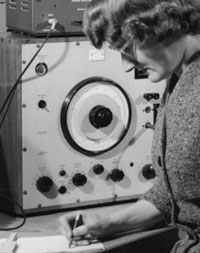Difference between revisions of "Wobbulator"
Martinwguy (talk | contribs) |
Martinwguy (talk | contribs) |
||
| Line 2: | Line 2: | ||
The [[Wobbulator]], also known as the '''B & K''', is a Brüel and Kjaer sine wave generator with frequency modulation<ref name=DD155144>[[DD155144]]: List of BBC Radiophonic Workshop facilities in Workshop 2 in 1963.</ref> which Delia used at the BBC Radiophonic Workshop. | The [[Wobbulator]], also known as the '''B & K''', is a Brüel and Kjaer sine wave generator with frequency modulation<ref name=DD155144>[[DD155144]]: List of BBC Radiophonic Workshop facilities in Workshop 2 in 1963.</ref> which Delia used at the BBC Radiophonic Workshop. | ||
| + | |||
| + | <BLOCKQUOTE> | ||
| + | “We had a thing called a Wobbulator, which has probably gone down in history, which is a huge oscillator in a wooden box, with a big circular dial, a knob which went all the way round if you could do it with a wrist movement. It also had a built-in modulator, and it was used for... if we were going to turn this into a recording studio, you'd have this thing in the middle of the table warbling away over various sweeps of different frequency ranges to pick out any standing waves that the room might generate. I mean, this one, because it's got trapezoid shapes and things. So, that gave you a good easy sweep and back in one movement, and of course, it was great for science fiction alarms, you just switched it on and set the wobble to whatever speed or depth you wanted it, and that was your alarms done, rather than chopping up bits of tape.”<ref>[[Dick Mills]] interviewed at [[Whooverville 5]].</ref> | ||
| + | </BLOCKQUOTE> | ||
=References= | =References= | ||
Latest revision as of 16:42, 15 December 2015
The Wobbulator, also known as the B & K, is a Brüel and Kjaer sine wave generator with frequency modulation[1] which Delia used at the BBC Radiophonic Workshop.
“We had a thing called a Wobbulator, which has probably gone down in history, which is a huge oscillator in a wooden box, with a big circular dial, a knob which went all the way round if you could do it with a wrist movement. It also had a built-in modulator, and it was used for... if we were going to turn this into a recording studio, you'd have this thing in the middle of the table warbling away over various sweeps of different frequency ranges to pick out any standing waves that the room might generate. I mean, this one, because it's got trapezoid shapes and things. So, that gave you a good easy sweep and back in one movement, and of course, it was great for science fiction alarms, you just switched it on and set the wobble to whatever speed or depth you wanted it, and that was your alarms done, rather than chopping up bits of tape.”[2]
References
- ↑ DD155144: List of BBC Radiophonic Workshop facilities in Workshop 2 in 1963.
- ↑ Dick Mills interviewed at Whooverville 5.
